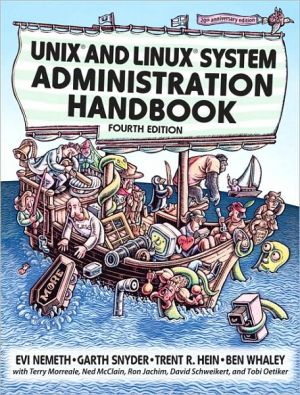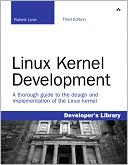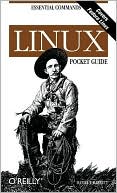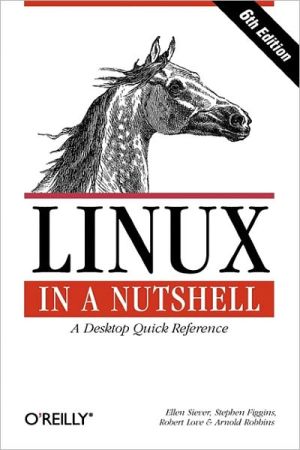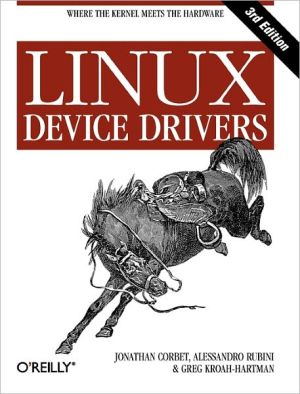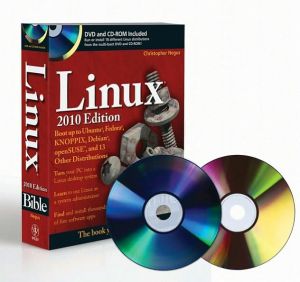UNIX and Linux System Administration Handbook
“As an author, editor, and publisher, I never paid much attention to the competition–except in a few cases. This is one of those cases. The UNIX System Administration Handbook is one of the few books we ever measured ourselves against.”\ –From the Foreword by Tim O’Reilly, founder of O’Reilly Media\ “This book is fun and functional as a desktop reference. If you use UNIX and Linux systems, you need this book in your short-reach library. It covers a bit of the systems’ history but doesn’t...
Search in google:
“As an author, editor, and publisher, I never paid much attention to the competition–except in a few cases. This is one of those cases. The UNIX System Administration Handbook is one of the few books we ever measured ourselves against.” –From the Foreword by Tim O’Reilly, founder of O’Reilly Media“This book is fun and functional as a desktop reference. If you use UNIX and Linux systems, you need this book in your short-reach library. It covers a bit of the systems’ history but doesn’t bloviate. It’s just straightfoward information delivered in colorful and memorable fashion.”–Jason A. Nunnelley“This is a comprehensive guide to the care and feeding of UNIX and Linux systems. The authors present the facts along with seasoned advice and real-world examples. Their perspective on the variations among systems is valuable for anyone who runs a heterogeneous computing facility.” –Pat ParseghianThe twentieth anniversary edition of the world’s best-selling UNIX system administration book has been made even better by adding coverage of the leading Linux distributions: Ubuntu, openSUSE, and RHEL.This book approaches system administration in a practical way and is an invaluable reference for both new administrators and experienced professionals. It details best practices for every facet of system administration, including storage management, network design and administration, email, web hosting, scripting, software configuration management, performance analysis, Windows interoperability, virtualization, DNS, security, management of IT service organizations, and much more. UNIX® and Linux® System Administration Handbook, Fourth Edition, reflects the current versions of these operating systems:Ubuntu® Linux openSUSE® Linux Red Hat® Enterprise Linux®Oracle America® Solaris™ (formerly Sun Solaris)HP HP-UX®IBM AIX® Booknews First covers the techniques needed to run a stand-alone UNIX system, then describes the protocols used on UNIX systems and the techniques to set up, extend, and maintain networks. The third edition covers Red Hat Linux. Annotation c. Book News, Inc., Portland, OR (booknews.com)
Preface \ When we were writing the first edition of this book in the mid-1980s, we were eager to compare our manuscript with other books about unix system administration. To our delight, we could find only three.\ \ These days, you have your choice of at least fifty. Here are the features that distinguish our book:\ \ We take a practical approach. Our purpose is not to restate the contents of your manuals, but rather to give you the benefit of our collective experience in system administration. This book contains plenty of war stories and a wealth of pragmatic advice.\ \ We cover unix networking in detail. It is the most difficult aspect of unix system administration, and the area in which we can most likely be of help to you.\ \ We do not oversimplify the material. Our examples reflect true-life situations, with all their warts and unsightly complications. In most cases, the examples have been taken directly from production systems.\ \ We emphasize the use of software tools. Every piece of software mentioned in the text is either a standard unix tool, or is included on the cd-rom at the back of this book sometimes both, since many vendors don't do a perfect job of keeping up with new releases.\ \ We cover all the major variants of unix. Our Six Example Systems There are two main flavors of unix: one from AT&T (original) and one from the University of California, Berkeley (extra crispy). Neither AT&T nor Berkeley is still active in the unix marketplace, but the terms at&t unix and Berkeley unix survive for historical reasons.\ \ This book covers six different operating systems:\ \ Solaris 2.4 SunOS 4.1.3\ hp-ux 9.0 dec'sosf/1 2.0\ irix 5.2 bsd/os 1.1\ \ We chose these systems because they are among the most popular, and because they illustrate a broad range of approaches to unix administration. The systems in the left column are predominantly derived from AT&T unix, while those on the right are more like Berkeley unix. We provide detailed information about each of these example systems for every topic that we discuss. Comments specific to a particular operating system are marked with the manufacturer's logo. There are many other versions of unix. Most fall within the range of variation defined by these six systems, but a few (such as aix and sco) are so beautifully strange that they must be taken on their own terms.\ \ The Organization of this Book.\ \ This book is divided into three large chunks: Basic Administration, Networking, and Bunch o Stuff. Basic Administration provides a broad overview of unix from a system administrator's perspective. The chapters in this section cover most of the facts and techniques needed to run a stand-alone unix system.\ \ The Networking section describes the protocols used on unix systems and the techniques used to set up, extend, and maintain networks. High-level network software is also covered here. Among the featured topics are the Domain Name System, the Network File System, network routing, and sendmail.\ \ Bunch o Stuff includes a variety of supplemental information. Some chapters discuss optional software packages such as uucp and the unix printing system. Others give sage advice on topics ranging from hardware maintenance to disk space management to the politics of running a unix installation.\ \ Aout the CD-ROM.\ \ The cd-rom contains software and reference information that we recommend for system administrators. Most of the items on the cd-rom are available over the Internet, but you may find the cd-rom faster and more convenient to use.\ \ The cd-rom uses the iso-9660 format, which is supported by most computers (including our six example systems). This format does not allow filenames longer than eight characters, so we have packaged up the tools using the standard unix tar command. Decoding instructions are included at the back of this book.\ \ The cd-rom will be updated on an approximately yearly basis. To determine the age of your copy, check the date printed on the cd-rom itself.
Where to Start. Booting and Shutting Down. Rootly Powers. Controlling Processes. The Filesystem. Adding New Users. Serial Devices. Adding a Disk. Periodic Processes. Backups. Syslog and Log Files. Devices and the Kernel. TCP/IP and the Internet. Routing. Network Hardware. The Domain Name System. The Network File System. Sharing System Files. Electronic Mail. Network Management. Security. Servers and Internet Hosting. Printing. Hardware Maintenance. Performing Analysis. Cooperating with Windows. Daemons. Policy and Politics.
\ From Barnes & Noble\ \ Fatbrain Review\ The authors assume that you have a certain amount of UNIX experience; in particular, a general concept of how UNIX looks and feels from a user's perspective. From their own practical experiences the authors give you an overview of the major administrative systems, introduce general administrative techniques, help you choose solutions that will continue to work well as your site grows in size and complexity, summarize common procedures saving you the time of digging through the manuals to accomplish simple tasks. This book is designed to be a compliment to, not a replacement for your system's documentation. Encompassing everything from adding new users, troubleshooting, adding hardware, configuring the Kernel, communications/networking, the Internet, policy and politics. A most complete UNIX system administration book.\ \ \ \ \ BooknewsFirst covers the techniques needed to run a stand-alone UNIX system, then describes the protocols used on UNIX systems and the techniques to set up, extend, and maintain networks. The third edition covers Red Hat Linux. Annotation c. Book News, Inc., Portland, OR (booknews.com)\ \
